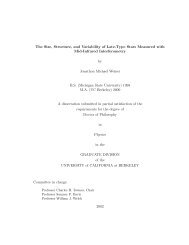Astro 160: The Physics of Stars
Astro 160: The Physics of Stars
Astro 160: The Physics of Stars
You also want an ePaper? Increase the reach of your titles
YUMPU automatically turns print PDFs into web optimized ePapers that Google loves.
Knowing that l∼ h we can derive the following relationshipnσ = κρ ρ = nσ Tl = 1κ T nσ = h = k bT¯mgthus we find that the density is given by and assuming ¯m ≈ m pρ =¯mgk b κ T T ≈ 8.26 × 10−4 g/cm 3b) In reality, the surface <strong>of</strong> the sun is so low that hydrogen is primarily neutral. <strong>The</strong>re are thus not thatmany free electrons to Thompson scatter <strong>of</strong>f <strong>of</strong>. <strong>The</strong> opacity at the surface <strong>of</strong> the sun is instead due to theH − ion and is given by κ ≈ 2.5 × 10 −31 ρ 1/2 T 9 cm 2 g −1 . Using this (correct) opacity, repeat the estimatefrom a) <strong>of</strong> the density at the photosphere <strong>of</strong> the sun.Substituting the opacity given into the above expression yieldsρ 3/2 =¯mg2.5 × 10 −13 kT 10b()¯mg 2/3⇒ ρ =2.5 × 10 −31 k b T 10 ≈ 9.8 × 10 −8 g/cm 3c) Just beneath the photosphere, energy is transported by convection, not radiation, for the reasonsdiscussed in class (in fact, the photosphere is the place where photons travel so freely out <strong>of</strong> the star thatenergy transport by radiation finally dominates over convection). Estimate the convective velocity nearthe photosphere given your density from b).<strong>The</strong> convective heat flux is given byF c = 1 ( 2Fc2 ρv3 c v c =ρand knowing thatF c = L4πr 2we find that the convective velocity is given byv c =) 1/3( ) 2L 1/34πr 2 ≈ 1.09 × 10 6 cm/sρd) What is the characteristic timescale for convective ”blobs” to move around near the pho-tosphere?How does this compare to the observed timescale for granulation on the surface <strong>of</strong> the sun, which was afew min in the movie we watched in class?since we know that the characteristic time scale is given byt blob = l v c≈ h v cwe know that h which is the scale height <strong>of</strong> the sun is given byh = kTg ¯m = 1.7 × 107 cm10












![Problem #1 [Structure Formation I: Radiation Era]](https://img.yumpu.com/37147371/1/190x245/problem-1-structure-formation-i-radiation-era.jpg?quality=85)



